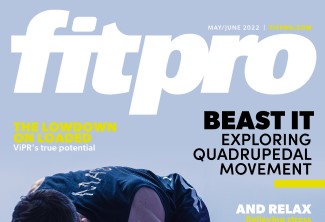Magazine References
May – Jun 2022

Pp 6-7 Escaping the desk trap
References
- Morris JN et al (1953), Coronary heart-disease and physical activity of work, Lancet, 262: 1,111-20.
- Paffenbarger RS et al (1970), Work activity of longshoremen as related to death from coronary heart disease and stroke. New England, J. Med. 282: 1,109.
- Woessnem MN et al (2021), The evolution of technology and physical inactivity: The good, the bad, and the way forward, Front. Public Health.
- Crum A, Langer E (2007), Mind-set matters: Exercise and the placebo effect, Psychol Sci., 18(2): 165-71.
- Levine J (2015), Sick of sitting, Diabetologia, 58(8): 1,751-58.
Pp 8-10 When healthy eating becomes a disorder
References
- Adapted Bratman Test, clinical-partners.co.uk. Available at: https://www.clinical-partners.co.uk/for-adults/eating-disorders-clinic/orthorexia-test
- Brytek-Matera A (2012), Orthorexia nervosa – an eating disorder, obsessive-compulsive disorder or disturbed eating habit? Archives of Psychiatry and Psychotherapy, 1: 55-60.
- Donini L, Marsili D, Graziani M et al (2004), Orthorexia nervosa: A preliminary study with a proposal for diagnosis and an attempt to measure the dimensions of the phenomenon, Eating Weight Disorders, 9(2): 151-7.
- Niedziel et al (2021), Prevalence of orthorexia nervosa and its diagnostic tools – A literature review, Eat Weight Disord., 24(4): 671-682.
- Koven N et al (2021), The clinical basis of orthorexia nervosa: Emerging perspectives, BMC Psychiatry, 21: 341.
- https://www.bda.uk.com/resource/orthorexia-can-healthy-eating-go-too-far.html, accessed on 2 November 2021.
- Turner P G & Lefevre C E (2017), Instagram use is linked to increased symptoms of orthorexia nervosa, Eat Weight Disord., 22: 277-84.
- https://www.nationaleatingdisorders.org/learn/by-eating-disorder/other/orthorexia, accessed on 2 November 2021.
- Segura-Garcia C, Ramacciotti C, Rania M, Aloi M, Carolea M, Bruni A, Gazzarrini D, Sinopoli F & De Fazio P (2014), The prevalence of orthorexia nervosa among eating disorders, Eat Weight Disord., 20: 161-6.
- Segura-Garcia C, Papaianni M, Caglioti F et al (2012), Orthorexia nervosa: A frequent eating disordered behaviour in athletes, Eating Weight Disord., 17(4): 226-33.
- Scarff et al (2017), Orthorexia nervosa: An obsession with healthy eating, Fed Pract., 34(6): 36-39.
- Novara et al (2021), Orthorexia nervosa: Differences between clinical and non-clinical samples, Int J environ Res Public Health, 18(10): 5,488.
Pp 14-15 And relax …
References
- Ooi SL, Pak SC (2019), The Landscape of Current Meditation Research: An Overview to the Special Issue on ‘Health Benefits of Meditation’, OBM Integrative and Complementary Medicine, 4(2): 8; doi:10.21926/obm.icm.1902033.
- https://www.cochranelibrary.com/search, accessed on 28 April 2022.
- https://www.headspace.com/meditation/benefits, accessed on 28 April 2022.
- https://www.livestrong.com/article/461667-should-you-meditate-or-exercise-first/, accessed on 28 April 2022.
- Alderman, B L et al (2016), MAP training: Combining meditation and aerobic exercise reduces depression and rumination while enhancing synchronized brain activity, Translational Psychiatry, 6(2): e726. doi:10.1038/tp.2015.225
- Norelli SK, Long A, Krepps JM (2022), Relaxation Techniques. [Updated 2021 Sep 6]. In: StatPearls [Internet]. Treasure Island (FL): StatPearls Publishing; Jan-. Available from: https://www.ncbi.nlm.nih.gov/books/NBK513238/, accessed on 28 April 2022.
Pp 18-21 Exploring quadrupedal movement the S&C trainer
References
- UK Chief Medical Officers’ Guidelines (2019).
- Dietz and Michel (2009), Human bipeds use quadrupedal coordination during locomotion, Ann N Y Acad Sci., 1,164: 97-103 (PMID: 19645886).
- Marder and Bucher (2001), Central pattern generators and the control of rhythmic movement, Curr Biol., 11: R986-996 (PMID: 11728329).
- Mathews, Yusuf, Doyle, Thompson (2016), Quadrupedal movement training improves markers of cognition and joint repositioning, Hum Mov Sci., 47: 70-80 (PMID: 26896559).
- Katy Bowman, https://www.nutritiousmovement.com/about-nutritious-movement/, accessed on 20 March 2022.
Pp 22-25 Corrective exercise solutions for walkers
References
- National Parks and Recreation Association (2016), Summer Fun: Where will you enjoy the outdoors this summer. Arlington, VA:Wakefield Research.
- Ehrman JK, Gordon P, Keteyian S, and Visich P (2009), Clinical Exercise Physiology, 2nd ed., Champaign, IL: Human Kinetics.
- Atkinson M (2012), Key Concepts in Sport and Exercise Research Methods, London, England: SAGE Publications.
- Hawkins JD, Hawkins SM (2011), Walking for Fun and Fitness, Belmont, CA: Wadsworth Cengage Learning.
- Hong Y, Ed. (2014), Routledge Handbook of Ergonomics in Sport and Exercise, New York: Routledge.
- Solberg G (2008), Postural Disorders and Musculoskeletal Dysfunction: Diagnosis, Prevention and Treatment, New York: Churchill, Livingston and Elsevier.
- DeLisa J, Ed. (2005), Physical Medicine and Rehabilitation: Principles and Practice, 4th ed. New York: Lippincott, Williams and Wilkins.
- Price J, Bratcher M (2019), The BioMechanics Method Corrective Exercise Specialist Certification Program (2nd Edition), San Diego, CA: The BioMechanics Press.
- Chapman A (2008), Biomechanical Analysis of Fundamental Human Movements. Champaign, IL: Human Kinetics.
- Whittle MW (1991), Gait Analysis: An Introduction, Oxford, England: Butterworth-Heinemann.
- Knudson D (2003), Fundamentals of Biomechanics, New York: Kluwer Academic/Plenum Publishers.
- Yates B, Ed. (2009), Merriman’s Assessment of the Lower Limb, London: Churchill, Livingstone, Elsevier.
Pp 30-33 Periodisation
References
- Haff GG, Triplett NT, editors (2015), Essentials of Strength Training and Conditioning, 4th edition, Human Kinetics.
- Jeffreys I, Moody J, editors (2021), Strength and Conditioning for Sports Performance, Routledge.
- Kiely J (2012), Periodization paradigms in the 21st century: evidence-led or tradition-driven?, International Journal of Sports Physiology and Performance, 7(3): 242-50.
- Zatsiorsky VM, Kraemer WJ, Fry AC (2020), Science and Practice of Strength Training, Human Kinetics.
- Fleck SJ, Kraemer WJ (1988), Resistance training: Physiological responses and adaptations (Part 3 of 4), The Physician and Sportsmedicine, 16(5): 63-76.
- Guppy SN, Haff GG (2021), Long-term programme design (periodisation). In Advanced Personal Training, Routledge, 118-128.
- Haff GG (2016), The essentials of periodisation, Strength and Conditioning for Sports Performance, 404.
- Plisk SS, Stone MH (2003), Periodization strategies, Strength & Conditioning, 25(6): 19-37.
- Stone MH, Stone M, Sands WA (2007), Principles and Practice of Resistance Training, Human Kinetics.
- Turner AN (2009), Training for power: Principles and practice, Professional Strength & Conditioning, 14: 20-32.
- Matveyev LP (1994), About the construction of training, Modern Athlete and Coach, 32(3): 12-6.
- Kok LY, Hamer PW, Bishop DJ (20090, Enhancing muscular qualities in untrained women: linear versus undulating periodization, Medicine & Science in Sports & Exercise, 41(9): 1,797-807.
- Harries SK, Lubans DR, Callister R (2016), Comparison of resistance training progression models on maximal strength in sub-elite adolescent rugby union players, Journal of Science and Medicine in Sport, 19(2): 163-9.
- Newton RU, Hakkinen K, Hakkinen A, McCormick M, Volek J, Kraemer WJ (2002), Mixed-methods resistance training increases power and strength of young and older men, Medicine and Science in Sports and Exercise, 34(8): 1,367-75.


